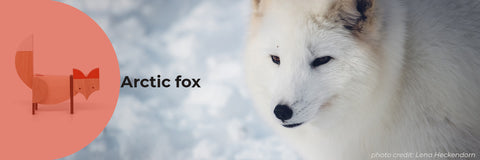Autumn is the most beautiful season in our town and we chose to present to you the most beautiful ESNAF TOY: the Nordic Fox. Foxes may have various coloring - red, grey, white… but the Arctic fox is our favorite and we will focus on it in the following post. We created the Nordic Fox toy using a minimum number of parts. That objective was part of the assignment we formulated in the beginning of the process. The Arctic fox has the minimum but key features that help it survive in the harsh conditions of the Arctic Circle. The Nordic Fox is one of our best-sellers and a part of the Nordic woods collection. The collection was created by architects for kids but it is most liked by design lovers. It was inspired by the BAUHAUS movement, and, with it, we want to share with our toddler collectors, and with you (their parents), little known facts behind each animal. Here is another set of stories you can tell your children.

photo credits: Lena Heckendorn
The Arctic fox is a type of fox - a member of the canidae family of animals, related to other foxes, wolves and dogs. Arctic foxes live on the land and sea ice within the Arctic Circle. Their whole body is adapted to this type of living and each and every single part of it is a weapon for surviving in the cold winter months in the Arctic area.
- Arctic foxes can be white, brown, or even blue-gray. Their color depends on the time of year and it changes with the season. The size of a large domestic cat, the Arctic fox is the smallest wild canine found in Canada. Females tend to be smaller than males, and their bushy tails account for 30-35% of their total length.

photo credits: Andrew Eaton
- They live in burrows (also called dens), with extensive tunnel systems. In a blizzard they make a tunnel into the snow to create shelter. Arctic fox dens may be used by several generations—some are as old as 300 years.

photo credits: pixabay
- An Arctic fox’s treats of choice are small rodents called lemmings, but when times are tough they’ll eat whatever they can find: insects, berries, and even the droppings of other animals. If a fox can’t find food, or if the weather gets really bad, it can dig a snow den and hunker down for up to two weeks. As long as the fox is sheltered and warm, it can slow down its heart rate and metabolism, which helps the animal save energy so it doesn’t have to eat as much. It’s similar to the way bears hibernate, but for a shorter period of time. Arctic foxes are well-known for their hunting skills. They are carnivores and scavengers, and they hunt rodents, birds and even fish.

photo credits: cup of couple, arthouse studio
- These foxes have adapted to life in the Arctic: the thick fur coat keeps the fox’s body warm; the long, fluffy tail acts like a blanket and keeps the fox warm when wrapped around its body during sleep; the feet are covered with a layer of thick fur, that makes it harder for prey to hear them approach; the white coat that make it difficult for predators such as wolves, polar bears and golden eagles to spot them in the ice and snow; small ears that reduce heat loss because less is exposed to the cold.
- They are mostly solitary animals. They are monogamous and they mate for life! Females give birth in the spring. They have large litters of 5-8 pups! Parents raise the pups together during the summer.
Our focus has always been on creating playful family moments. But we also aim to go beyond playfulness and add an educational component to our toys. We believe the best and the most natural way to learn is while playing. Telling these curious stories while you play with your kids can add value to your time together.

photo credits: Polina Ilieva photography
Toys for life!
Sources: thebiggreenk, arctic kingdom, kids national geographic


